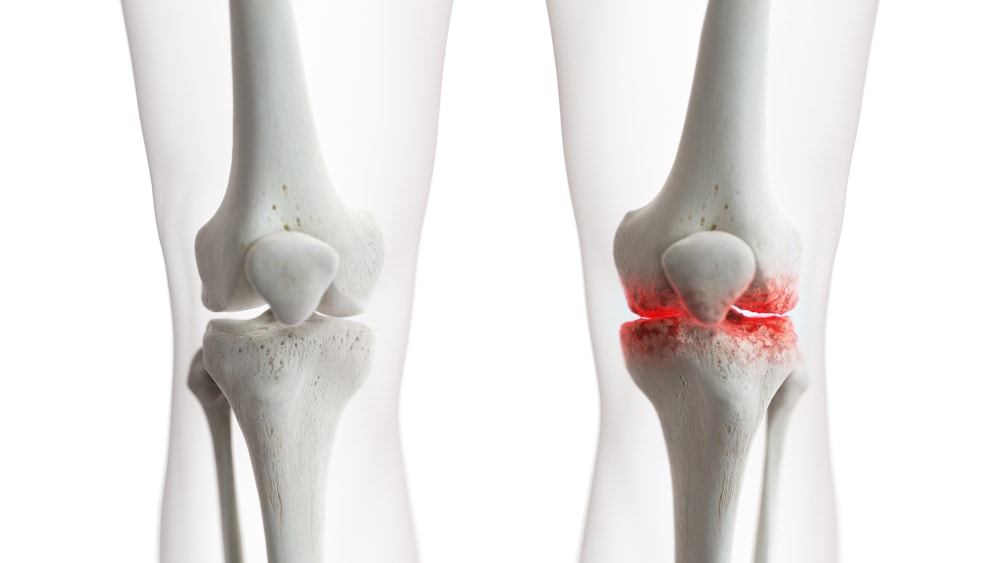PRP Again Beats Steroid and Hyaluronic Acid Shots

Credit: Shutterstock
PRP for the treatment of knee osteoarthritis has more evidence to support it than knee replacements, but the old guard is having a tough time accepting this new reality. A recent study in an old guard orthopedic journal could change some minds. Let’s review.
Definitions
Before I begin, we need to define some things:
- Corticosteroid injections – Injecting high-dose (milligram range) steroid medication to reduce inflammation.
- Hyaluronic Acid – Also known as HA or gel shots, these are a synthetic type of synovial fluid that can cushion the arthritic knee joint and may help improve the chemical composition of the joint fluid.
- PRP – Platelet-rich Plasma – These are injections of the patient’s concentrated platelets to enhance healing/repair and also to improve the chemical composition of the joint fluid.
The Research on PRP in Knee OA

The table above is from a research study that looked for orthopedic research studies comparing surgery to conservative care or placebo (3). It shows that after reviewing 344 research papers to find one that compared knee replacement to sham surgery or conservative care, only one randomized controlled trial was found. That should astound and upset you that a hyperinvasive surgery that has cost the US healthcare system many billions of dollars only has a single RCT showing that it’s marginally better than physical therapy. How many such papers exist showing that PRP is better than those comparators? 19 individual studies!
The New Research
In this new study published in the orthopedic surgery old guard journal Arthroscopy, the authors reviewed 79 studies involving 8,761 patients (1). They compared corticosteroid injection, hyaluronic acid, and PRP (the red stuff or leukocyte-rich). In the long-term pain relief game, PRP beat the other two at one year post-injection. In fact, it was the only one of the three treatments that could be considered a long-term solution.
This Was LR-PRP
There are two main types of injectable PRP – amber and red. The amber stuff is red and white blood cell poor (LP) and the red stuff is red and white blood cell rich (LR). In general, better results have been reported for the amber PRP than red, so this study used the less effective type.
The Side Effects of Corticosteroids
We’ve known for some time that steroids damage cartilage (2). So why would you want your mainstay treatment for lost cartilage (osteoarthritis) to damage cartilage? That makes no common sense, yet this is used as a treatment for knee osteoarthritis about a million times a year by physicians.
Is HA OK?
I often get asked this by patients. While steroid shots can damage the joint, HA shots can help the joint. While they aren’t as good as PRP when compared head to head, they don’t hurt the joint. So if you had to try an insurance-covered solution before PRP, HA would be it.
Is All PRP the Same?
No, not all PRP is the same. As above, there are two types, but the dose is also important. Most bedside machines can only produce PRP with 3-7 times as many platelets as your blood. This works well in our experience if you’re younger. If you’re middle-aged or older, we use much higher doses. Meaning 10-20 times over what’s in your blood.
Are All Degrees of Arthritis Treatable?
PRP tends to work better for mild to moderate knee arthritis. For moderate to severe arthritis, we recommend Bone Marrow Concentrate.
The upshot? PRP beats the pants off steroid and HA shots, again! More publications like this will help orthopedic surgeons (the old guard) begin to accept that PRP is the way to go for mild to moderate knee OA.
____________________________________________
References:
(1) Mojica ES, Markus DH, Blaeser AM, Hurley ET, Jazrawi LM, Campbell KA, Strauss EJ. Estimated Time to Maximum Medical Improvement of Intra-articular Injections in the Treatment of Knee Osteoarthritis – A Systematic Review. Arthroscopy. 2021 Aug 27:S0749-8063(21)00777-5. doi: 10.1016/j.arthro.2021.08.026. Epub ahead of print. PMID: 34461219.
(2) McAlindon TE, LaValley MP, Harvey WF, et al. Effect of Intra-articular Triamcinolone vs Saline on Knee Cartilage Volume and Pain in Patients With Knee Osteoarthritis: A Randomized Clinical Trial. JAMA.2017;317(19):1967–1975. doi: 10.1001/jama.2017.5283.
(3) Blom AW, Donovan RL, Beswick AD, Whitehouse MR, Kunutsor SK. Common elective orthopaedic procedures and their clinical effectiveness: umbrella review of level 1 evidence. BMJ. 2021 Jul 7;374:n1511. doi: 10.1136/bmj.n1511. PMID: 34233885.

If you have questions or comments about this blog post, please email us at [email protected]
NOTE: This blog post provides general information to help the reader better understand regenerative medicine, musculoskeletal health, and related subjects. All content provided in this blog, website, or any linked materials, including text, graphics, images, patient profiles, outcomes, and information, are not intended and should not be considered or used as a substitute for medical advice, diagnosis, or treatment. Please always consult with a professional and certified healthcare provider to discuss if a treatment is right for you.
